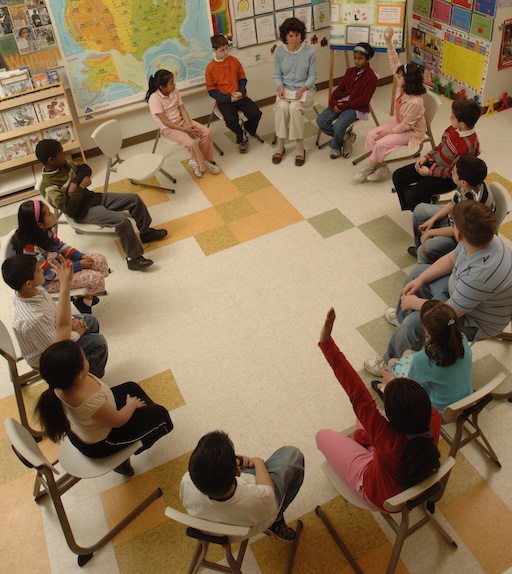Open Circle Research
Open Circle helps children by promoting their health and well-being and contributing to the prevention of violence, truancy, bullying, and drug and alcohol abuse. In addition, Open Circle's curriculum is associated with an increase in attendance, as well with significant gains in student engagement and academic achievement tests.
Open Circle is Evidence and Research Based
Two research studies have demonstrated Open Circle’s positive impact on students’ skills and behavior. The first study found that after receiving one year of Open Circle instruction, both urban and suburban students demonstrated greater social skills and fewer problem behaviors than students in control groups. The largest gains were made by students in urban areas. 
The second study examined middle school students with at least two prior years of Open Circle participation and found that girls showed an increase in self-assertiveness and boys showed higher levels of social skills and self-control and fewer problems with physical fighting.
Open Circle is Nationally Recognized
Open Circle is included on several national lists for its proven effectiveness:
-
2013 CASEL Guide to Effective Social and Emotional Learning Programs
-
U.S. Substance Abuse and Mental Services Administration’s National Registry of Evidence- based Programs and Practices (NREPP)
-
Model Program for the National Dropout Prevention Center
-
Office of Juvenile Justice and Delinquency Prevention Model Programs Guide
-
U.S. Department of Education’s Guidebook for Exemplary and Promising Safe, Disciplined, and Drug-Free Schools Programs
-
Robert Wood Johnson Foundation Prize for Activating Empathy CompetitionResearch and Survey Findings
In 2009, CASEL published a major meta-analysis of 207 rigorous research studies. The studies evaluated over 700x programs serving more than 288,000 children from urban, suburban, and rural schools. The meta-analysis indicated that school-based programs like Open Circle provide massive benefits to students who use them.
The study found that effective programs are usually sequenced, active, focused, and explicit (S.A.F.E.). The Open Circle Curriculum meets CASEL’s “S.A.F.E.” standard with its Sequenced and grade-differentiated lessons, Active learning tools (e.g. role-plays, games), Focused time (two 15-minute Open Circle Meetings per week), and Explicit social and emotional skill development.
For more information, visit www.casel.org.
Research and Survey Findings
Increased Self-Assertiveness, Higher Social Skills, Improved Self Control, And Fewer Physical Fights
Taylor, C. A., Liang, B., Tracy, A. J., Williams, L. M., & Seigle, P. (2002). Gender Differences in Middle School Adjustment, Physical Fighting, and Social Skills: Evaluation of a Social Competency Program. The Journal of Primary Prevention, 23(2), 259–72.
This study assessed the effects of Open Circle on 277 sixth grade middle school students with varying levels of exposure to Open Circle during elementary school. Data collected included students’ self-reports and parents’ and teachers’ perceptions of the children. Social skills were measured using the Social Skills Rating System (SSRS). Middle school adjustment was measured using a modified version of the Survey of Adaptation Tasks—Middle School and addressed issues related to peer relationships, substance abuse, and interpersonal conflict.
The study found positive effects on middle school adjustment for both girls and boys. Middle school girls who had previously participated in at least two years of Open Circle showed a significant increase in self-assertiveness when compared to non-participants. Middle school boys with at least two years of Open Circle participation reported higher levels of social skill and self control and fewer problems with physical fighting.
Improved Social Skills And Fewer Problem Behaviors
Hennessey, B. A. (2007). Promoting Social Competence in School-Aged Children: The Effects of the Open Circle Program. Journal of School Psychology, 45, 349-360.
This study involved 150 fourth grade students and their teachers in eight classrooms at four elementary schools. Four classrooms used the Open Circle and were compared to four control group classrooms that did not use the Open Circle. Participants completed the student version of the Social Skills Rating System (SSRS). Teachers also rated the social competence of students at these same two points in the school year. In the fall, students in the participating classrooms appeared similar – both academically and socially – to those in the control classrooms.
This study found that after one year of using the Open Circle Curriculum, Open Circle participants showed significantly greater teacher-reported improvements in both social skills and problem behaviors than did control group members. Although the largest gains were made by Open Circle students in urban areas, significant positive effects of program participation were shown by all students, regardless of school setting.
SURVEY FINDINGS
Open Circle continually assesses its program effectiveness through training evaluation forms, class and school observations, and surveys of teachers, principals, support staff, and students.

CASEL RESEARCH ON SOCIAL AND EMOTIONAL LEARNING
Durlak, J.A., Weissberg, R. P., Dymnicki, A. B., Taylor, R. D., & Schellinger, K. (in press). The Impact of Enhancing Students’ Social and Emotional Learning: A Meta-Analysis of School-Based Universal Interventions. Child Development.
This meta-analysis of 207 rigorous research studies found that students engaged in evidence- based and well-implemented social and emotional learning programs showed:
-
Increased achievement test scores in reading and math by 11 percentile points;
-
Improved social and emotional skills by 23 percentile points;
-
Improved attitudes about self, others, and school by 9 percentile points;
-
Improved prosocial school and classroom behavior by 9 percentile points;
-
Decreased conduct problems by 9 percentile points; and
-
Decreased emotional distress by 10 percentile points.
